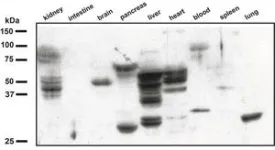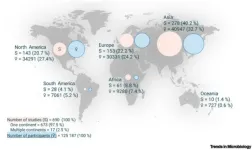(Press-News.org) CLEVELAND—Nearly every disease has an inflammatory component, but blood tests can’t pinpoint inflammation in specific organs or tissues in the human body.
Now researchers at Case Western Reserve University have developed a method to detect inflammation using antibodies, potentially leading to blood tests for disease-specific biomarkers such as for heart disease, Alzheimer’s disease and various cancers. Their breakthrough also holds promise for drug discovery.
“This research opens up an amazing number of pathways for future studies,” said Greg Tochtrop, professor of chemistry at Case Western Reserve. “It will lead directly to better understanding inflammation and detecting diseases, as well as to discovering new drugs.”
The research, which Tochtrop led, is published today in the journal Proceedings of the National Academy of Sciences (PNAS).
Inflammation leaves a trace
Tochtrop discovered that certain compounds formed from the interaction with reactive oxygen species (ROS)—highly reactive oxygen-containing chemicals that can damage DNA, proteins and lipids—react in a very unique way allowing detection using antibodies.
During inflammation, immune cells produce ROS to kill bacteria and other pathogens. ROS can also be generated by exposure to environmental factors like ultraviolet light, pollution, radiation and smoking. Excessive ROS can damage cells and tissues.
Tochtrop and colleagues investigated how ROS could react with linoleic acid, a fatty acid found in all cell membranes, forming compounds that can bind to RNA, DNA and proteins, called epoxyketooctadecanoic acids (EKODEs).
Tochtrop found that EKODEs react with the nucleic acid cysteine in a way that had never been described before, forming a stable bond. These compounds then accumulate in tissues throughout the body suffering from oxidative stress, like the brain, heart, liver and other organs. Tochtrop developed antibodies to these compounds from mouse models and was able to detect buildup of different types of EKODEs in various tissues, both in mice and humans.
“What makes this so interesting and so potentially valuable,” Tochtrop said, “is that we could detect unique compounds and concentrations in different tissues and organs, which means that you could potentially detect a variety of diseases with a blood test.”
The test could be similar to the A1C test for diabetes, which measures the percentage of hemoglobin in the blood coated with glucose, indicating the level of glucose circulating in the blood over the past three months. An EKODE test could reveal abnormal oxidative stress in specific organs.
Searching for disease-specific biomarkers
The next step, according to Tochtrop, is to identify different EKODE targets in various organs and tissues to correlate biomarkers with specific diseases. He is particularly interested in EKODEs produced in the eye in response to age-related macular degeneration or diabetic retinopathy that affect vision.
Tochtrop explained why these biomarkers had not been identified before: “We had to develop many of the tools in the lab to search for them in the first place,” he said.
The researchers synthesized EKODE model compounds and then studied how they reacted with different amino acids, finding that cysteine is the only one that EKODE bound to for any length of time.
“We looked at the inherent chemistry of the system, predicted what would form and then searched for them,” he said. “There are very important translational implications, but this is an example of how looking at things from first principles can really inform the next steps to developing clinical tests.”
Potential for discovering new drugs
The research could also aid drug discovery, as drug developers are looking for reactive cysteines.
“Identifying reactive cysteines is central to drug discovery right now,” he said. “This could help uncover many reactive cysteines that could be targeted for drug discovery, which is a valuable offshoot of our research.”
###
At Case Western Reserve, one of the nation's leading research universities, we're driven to seek knowledge and find solutions to some of the world's most pressing problems. Nearly 6,200 undergraduate and 6,100 graduate students from across 96 countries study in our more than 250 degree programs across arts, dental medicine, engineering, law, management, medicine, nursing, science and social work. Our location in Cleveland, Ohio—a hub of cultural, business and healthcare activity—gives students unparalleled access to engaging academic, research, clinical, entrepreneurial and volunteer opportunities and prepares them to join our network of 125,000+ alumni making an impact worldwide. Visit case.edu to learn more.
END
A new way to detect inflammation
Chemistry researchers at Case Western Reserve University have found specific markers that may lead to new blood tests for disease
2025-02-06
ELSE PRESS RELEASES FROM THIS DATE:
Crohn's & Colitis Congress® spotlights key IBD research findings
2025-02-06
San Francisco, CA (Feb. 5, 2025) – The Crohn’s & Colitis Foundation and the American Gastroenterological Association (AGA) are excited to host the annual Crohn’s & Colitis Congress®, taking place Feb. 6-8, in San Francisco, CA. This premier event will showcase cutting-edge research, innovative technologies, and advanced patient care strategies set to transform the lives of one in 100 Americans living with inflammatory bowel disease (IBD), including Crohn’s disease and ulcerative colitis.
Below ...
Vanilla farmers search for a crop and conservation sweet spot
2025-02-06
Vanilla is vital to the livelihoods of farmers in Madagascar, where the globally popular dessert ingredient is the country’s No. 1 export. A fun, thought-provoking game designed by a team of scientists and played by Malagasy vanilla farmers reveals the challenges of payment programs that incentivize forest conservation in the region, according to a study led by the University of California, Davis.
The study, published in the February issue of the journal Biological Conservation, found that even amid volatile markets and climate uncertainties, farmers highly value their vanilla crops, which are tied ...
Global “sisterhood” seeks to understand what makes a healthy vaginal microbiome
2025-02-06
Vaginas host a complex microcosm of bacteria and yeasts that can fluctuate over time. However, little is known about these microbial communities and their roles in a person’s health, and 9 out of 10 studies only include participants from one continent, resulting in major geographical gaps in data. In a paper publishing February 6 in the Cell Press journal Trends in Microbiology, scientists share insights gleaned from a “sisterhood” of thousands of citizen scientists and demonstrate how international collaboration can help illuminate the gaps in our knowledge about the vaginal microbiome, including which bacteria are helpful ...
Announcing the winners of the 5th annual Rising Black Scientists Awards
2025-02-06
Four early-career scientists share how they’ve harnessed features of their lives—from music to AI technology—to inspire their career and uplift communities. Each winner receives $10,000 for their science with essays published in the journal Cell
Cell Press, Cell Signaling Technology (CST), and the Elsevier Foundation are proud to announce the winners of the 5th annual Rising Black Scientists Awards: Jheannelle Johnson of Stanford University; Victor Ekuta, MD, of the Morehouse School of Medicine; Kenna Gloria Agbugba of Philander Smith ...
Food: Cracking the method for the ‘perfect’ boiled egg
2025-02-06
A new method pioneered to optimally cook both the yolk and white (or albumen) of a boiled chicken egg has been published in Communications Engineering. The approach, which the authors call periodic cooking, yields an evenly-cooked egg with a higher nutritional content than shell-on eggs cooked by conventional boiling or sous vide methods.
The yolk and white in chicken eggs cook at two different temperatures: the albumen cooks at 85 degrees Celsius, while the yolk cooks at 65 degrees Celsius. Conventional methods for cooking ...
Cannabis use disorder emergency department visits and hospitalizations and 5-year mortality
2025-02-06
About The Study: In this cohort study of all residents of Ontario, Canada, individuals with incident hospital-based cannabis use disorder care were at markedly increased risk of death compared with the general population. These findings suggest important clinical and policy implications, given global trends toward cannabis legalization and market commercialization accompanied by increasing cannabis use and cannabis use disorders.
Corresponding Author: To contact the corresponding author, Daniel ...
COVID-19 pandemic and rates of common ophthalmic procedures among Medicare beneficiaries
2025-02-06
About The Study: The results of this study show that the COVID-19 pandemic caused a notable drop in the number of common ophthalmic procedures among Medicare beneficiaries, especially in laser peripheral iridotomy, while eye drug injections saw minimal changes. The Northeast experienced the largest reductions, highlighting the pandemic’s association with changes in eye care and indicating a need for focused recovery efforts in the hardest hit areas.
Corresponding Author: To contact the corresponding author, Jessica D. Randolph, MD, email jessica.randolph@vcuhealth.org.
To access the embargoed study: Visit our For The Media website at this link https://media.jamanetwork.com/
(doi:10.1001/jamaophthalmol.2024.6065)
Editor’s ...
Updated drug information handout outdoes FDA’s version
2025-02-06
A clinical trial comparing a one-page medication handout proposed by the U.S. Food and Drug Administration (FDA) with an updated version developed by researchers at the University of Pittsburgh that quantifies a drug’s risk and benefits showed that the latter was more informative and helped patients feel better equipped to make decisions.
Published today in JAMA Network Open, the study, which used the drug mifepristone as an example, highlights the importance of communicating risks and benefits of prescription medications – ...
Gemini North teams up with LOFAR to reveal largest radio jet ever seen in the early universe
2025-02-06
From decades of astronomical observations scientists know that most galaxies contain massive black holes at their centers. The gas and dust falling into these black holes liberates an enormous amount of energy as a result of friction, forming luminous galactic cores, called quasars, that expel jets of energetic matter. These jets can be detected with radio telescopes up to large distances. In our local Universe these radio jets are not uncommon, with a small fraction being found in nearby galaxies, but they have remained elusive in the distant, early Universe until now.
Using a combination of telescopes, astronomers have discovered a distant, two-lobed radio ...
Researchers discover a major driver of inflammatory pathology in autoimmune and chronic inflammatory diseases
2025-02-06
Our immune system is armed with an array of defenses designed to detect and eliminate harmful threats. One of its most powerful defense mechanisms is the complement system—a group of proteins that patrols our body, ever vigilant for signs of infection or injury. Now, over 100 years after the complement system was first described, researchers at Mass General Brigham have discovered that a protein known as granzyme K (GZMK) drives tissue damage and inflammation by activating the complement system against our own tissues. Their findings not only reshape the century-old understanding of the complement system but also open new avenues for therapies that could specifically ...
LAST 30 PRESS RELEASES:
UVA’s Jundong Li wins ICDM’S 2025 Tao Li Award for data mining, machine learning
UVA’s low-power, high-performance computer power player Mircea Stan earns National Academy of Inventors fellowship
Not playing by the rules: USU researcher explores filamentous algae dynamics in rivers
Do our body clocks influence our risk of dementia?
Anthropologists offer new evidence of bipedalism in long-debated fossil discovery
Safer receipt paper from wood
Dosage-sensitive genes suggest no whole-genome duplications in ancestral angiosperm
First ancient human herpesvirus genomes document their deep history with humans
Why Some Bacteria Survive Antibiotics and How to Stop Them - New study reveals that bacteria can survive antibiotic treatment through two fundamentally different “shutdown modes”
UCLA study links scar healing to dangerous placenta condition
CHANGE-seq-BE finds off-target changes in the genome from base editors
The Journal of Nuclear Medicine Ahead-of-Print Tip Sheet: January 2, 2026
Delayed or absent first dose of measles, mumps, and rubella vaccination
Trends in US preterm birth rates by household income and race and ethnicity
Study identifies potential biomarker linked to progression and brain inflammation in multiple sclerosis
Many mothers in Norway do not show up for postnatal check-ups
Researchers want to find out why quick clay is so unstable
Superradiant spins show teamwork at the quantum scale
Cleveland Clinic Research links tumor bacteria to immunotherapy resistance in head and neck cancer
First Editorial of 2026: Resisting AI slop
Joint ground- and space-based observations reveal Saturn-mass rogue planet
Inheritable genetic variant offers protection against blood cancer risk and progression
Pigs settled Pacific islands alongside early human voyagers
A Coral reef’s daily pulse reshapes microbes in surrounding waters
EAST Tokamak experiments exceed plasma density limit, offering new approach to fusion ignition
Groundbreaking discovery reveals Africa’s oldest cremation pyre and complex ritual practices
First breathing ‘lung-on-chip’ developed using genetically identical cells
How people moved pigs across the Pacific
Interaction of climate change and human activity and its impact on plant diversity in Qinghai-Tibet plateau
From addressing uncertainty to national strategy: an interpretation of Professor Lim Siong Guan’s views
[Press-News.org] A new way to detect inflammationChemistry researchers at Case Western Reserve University have found specific markers that may lead to new blood tests for disease





